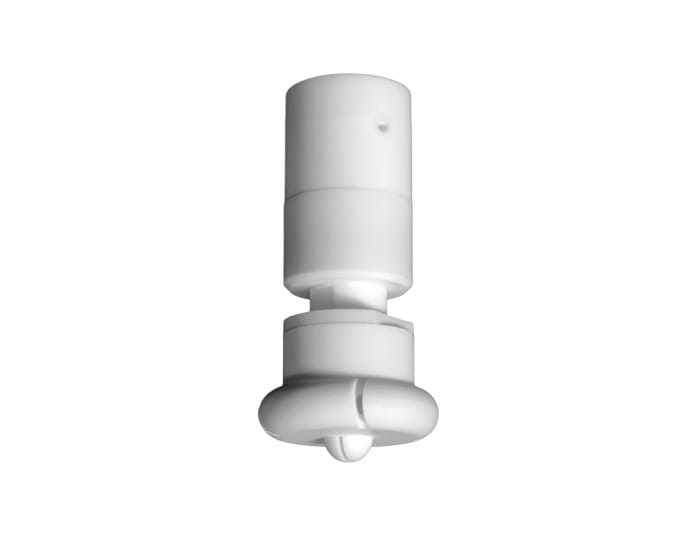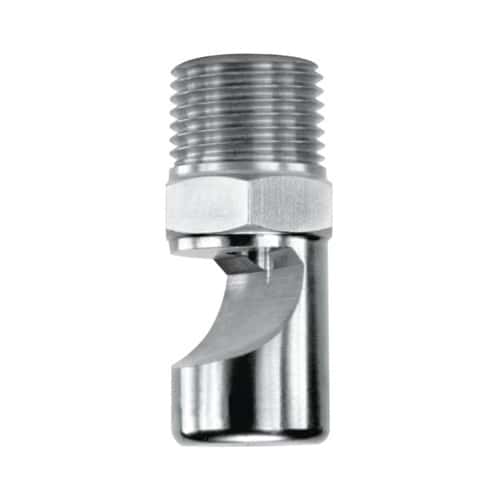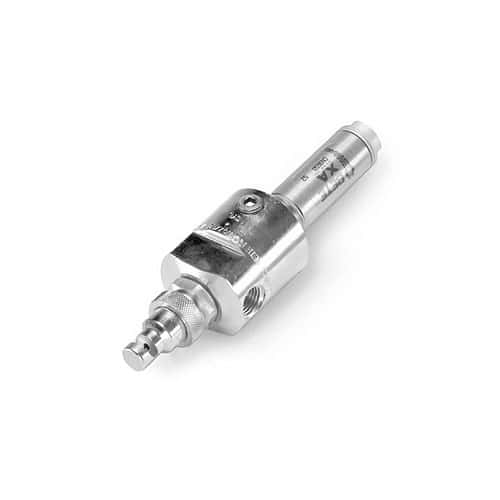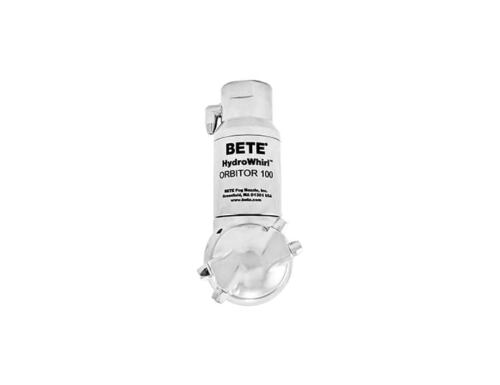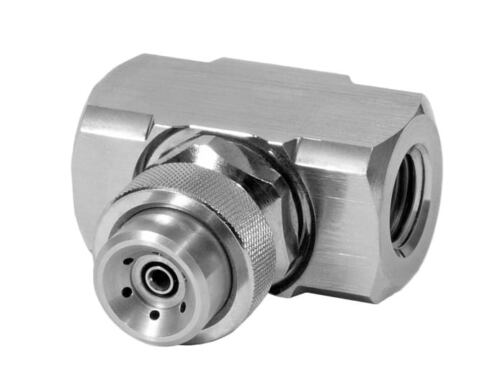Tank cleaning spray nozzles are ideal for high-impact cleaning
- Cleans more quickly, and uses less water and lower pressure than static tank washers
- PTFE construction:
– Ideal for harsh chemical environments
– Corrosion resistant
- Four connections: threaded, pipe, tube, or DIN clip-on.
- Made from FDA-approved materials for use in Clean-In-Place (CIP) applications
- Slow spinning, longer spray dwell time on the target surface increases impact over conventional rotating designs
- Complete 360° omnidirectional spray pattern
The HydroWhirl Poseidon® is a versatile Clean-In-Place (CIP) rotating tank-washing nozzle that combines slow moving rotation and high-impact spray pattern for more efficient tank cleaning. It is ideal for tanks up to 22 ft. in diameter often found in the food, beverage, chemical, and pharmaceutical industries where superior cleaning with reduced cycle times and low water, energy and chemical consumption are important considerations.
The bearingless design provides a slow, nearly constant rotation speed over the operating pressure range. The slow, nearly constant rotation speed of the HWP results in more efficient cleaning and use of resources over static spray balls and other rotating spray ball designs through increased impact and longer spray dwell time on the target surface.
View Static Spray Balls
Tank washing is an important job in many industrial applications, and can be time-consuming and expensive without the correct solution for the given application. Storage tanks, process vessels, reactors, and process equipment can vary significantly in scope and size across all industries. However, almost all of these tanks must be cleaned before and/or after use to ensure sanitation and prevent product contamination.
Spray nozzles can help to maximise the efficiency of washing applications by ensuring proper distribution of the cleaning media and/or maximising impact from the available flow rate/pressure of the system, reducing operating and disposal costs. They can offer significant time and money saving over other cleaning options such as “fill and drain” or manual entry (especially in hazardous environments). There are several types of tank washing nozzles available that can help to efficiently use the resources available to meet the specific application conditions and requirements.
Selecting a Tank Washing Nozzle:
Important factors to consider:
-
Type of tank washing nozzle to be selected
- Static spray nozzles: these nozzles remain stationary and distribute the cleaning fluid through multiple nozzles, or other directional means (i.e. spiral). Without any moving components, these style of nozzles are typically durable and clog resistant, providing reliable operation and long service lives. However, as they must distribute the cleaning fluid over the entire target surface at once, they generally require the largest flow rates and provide the least amount of impact in washing applications.
- Rotating spray balls: these nozzles use spinning heads that rotate and are generally driven by the reactionary force of the cleaning liquid leaving the head. As these rotating spray balls concentrate the spray media into smaller fan patterns and rotate these around the tank to provide complete coverage, they are significantly more efficient and use comparatively a much smaller amount of cleaning fluid or less cleaning time than static nozzles. Some reaction force nozzles are free-spinning while others rotate much more slowly.
- Tank cleaning machines/rotating jet nozzles: these tank cleaning machines use concentrated cleaning jets or fans that rotate within two planes to provide a complete orbital spray pattern for tank cleaning. These nozzles are generally driven by the cleaning liquid flowing through an internal turbine or gear which rotates the nozzle at a controlled speed but some models may also use an electric or pneumatic motor to provide/control the necessary rotation. The concentrated spray jets utilized by these styles of nozzles maximize the impact force from the available flow rate/pressure and are ideal for large tanks requiring significant throw lengths from the nozzle and/or cleaning difficult residues such as peanut butter, BBQ sauce, paint, glues, resins, and etc.
-
Tank/vessel size and shape
- Available nozzle placement/mounting positions
- Internal vessel components (mixers, baffles, down pipes, etc.)
- Potential to cause ” shadow” areas by blocking spray
-
Application details and requirements
- Residue to be removed
- Rinsing
- Soluble with water, soaps, detergents, or other chemicals
- High impact washing required for removal
- Temperature and chemical composition of wash fluid
- Required materials of construction for corrosive residues and spray media
- Closed vs. open top vessels
- Permanent (CIP) vs portable installations
- Required surface finish
- Potentially explosive environments (ATEX)
Common Tank Washing Nozzle Uses and Industries
- Chemical processing industry
- Brewery and winery industry
- Food processing industry
- Manufacturing industry
- Waste management industry
- Pulp and paper industry
- Bright beer tanks
- Brew kettles
- Fermentors
- Mixers
- Cooking kettles
- Spray driers
- Large commercial ovens and freezers
- Reactors
- Process vessels
- Storage tanks
- Underground storage tanks (UST) and above ground storage tanks (AST)
- Oil and gas storage tanks
- Drilling mud tanks
- Lift stations and wet wells


